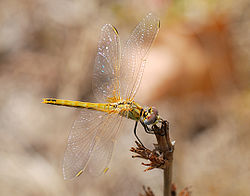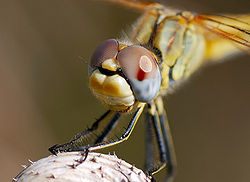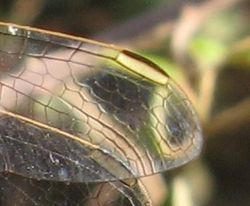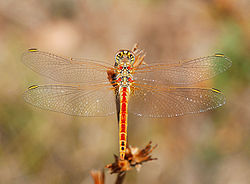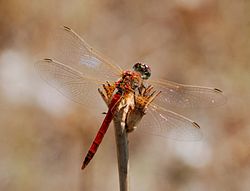- Red-veined darter
-
Red-veined darter 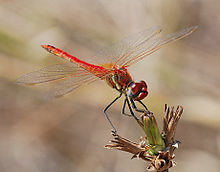
Male red-veined darter Scientific classification Kingdom: Animalia Phylum: Arthropoda Class: Insecta Order: Odonata Suborder: Anisoptera Family: Libellulidae Genus: Sympetrum Species: S. fonscolombii Binomial name Sympetrum fonscolombii
(Selys, 1840)The Red-veined Darter (Sympetrum fonscolombii) is a dragonfly of the genus Sympetrum. It is a common species in southern Europe and from the 1990s onwards has increasingly been found in northwest Europe, including Britain and Ireland. Its name is sometimes spelt fonscolombei instead of fonscolombii but Askew (2004) gives the latter as the correct spelling. There is genetic and behavioural evidence that S. fonscolombii is not closely related to the other members of the Sympetrum genus and will at some time in the future be removed from this genus.
Contents
Identification
S. fonscolombii is similar to other Sympetrum species but a good view with binoculars should give a positive identification, especially with a male. Males have a red abdomen, redder than many other Sympetrum species. The wings have red veins and the wing bases of the hind-wings are yellow. The pterostigma are pale with a border of black veins and the underside of the eye is blue/grey. The female is similar but the abdomen is yellow, not red, and the wings have yellow veins, not red veins as found in the males. The legs of both sexes are mostly black with some yellow. Immature males are like females but often with more red.
Male S. fonscolombii can be mistaken for Crocothemis erythraea as both are very red dragonflies with yellow bases to the wings, red veins and pale pterostigma. However C. erythraea has no black on the legs, a broader body and no black on the head. Also C. erythraea females do not oviposit in tandem. The jizz of these two species is different and with some experience are easy to tell apart.Distribution and habitat
Occurs in much of central and southern Europe including most Mediterranean islands, in Africa, the Middle East and south-western Asia including India, Sri lanka, and Mongolia. In Europe it is resident in the south of its range but in some years it migrates northward and has been found as far north as Belgium, Sweden, Finland, Poland and northern England. It is the only libellulid to be found in the Azores and it is also found on the Canary islands and Madeira.
It is found in all sorts of still water but being a migrant it is often found away from water. It has been seen flying over the sea.Behaviour
S. fonscolombii can be seen on the wing throughout the year around the Mediterranean and in the south of its range, however, its main flight period is May to October and it is scarce during the winter months. It is a territorial species with the males often sitting on an exposed perch. After copulation the pair stay in tandem for egg laying and pairs can be seen over open water with the female dipping her abdomen into the water depositing eggs. Pairs are known to fly over the sea in tandem dipping into the salt water where the eggs soon perish. The eggs and larvae develop rapidly and S. fonscolombii unlike most other European dragonflies has more than one generation a year.
References
- Askew, R.R. (2004) The Dragonflies of Europe. (revised ed.) Harley Books.pp180 and 213 . ISBN 0946589755
- Boudot JP., et al. (2009) Atlas of the Odonata of the Mediterranean and North Africa. Libellula Supplement 9:1-256.
- Dijkstra, K-D.B & Lewington, R. (2006) Field Guide to the Dragonflies of Britain and Europe. British Wildlife Publishing. ISBN 0953139948.
External links
- British Dragonfly Society http://british-dragonflies.org.uk/species/red-veined-darter
- Pictures from Red-veined darter http://www.odonata.su/index.php?name=db&op=taxon_photo&id=208
 Media related to Sympetrum fonscolombii at Wikimedia Commons
Media related to Sympetrum fonscolombii at Wikimedia Commons Data related to Sympetrum fonscolombii at Wikispecies
Data related to Sympetrum fonscolombii at Wikispecies
Categories:- Dragonflies of Europe
- Libellulidae
- Animals described in 1840
Wikimedia Foundation. 2010.

